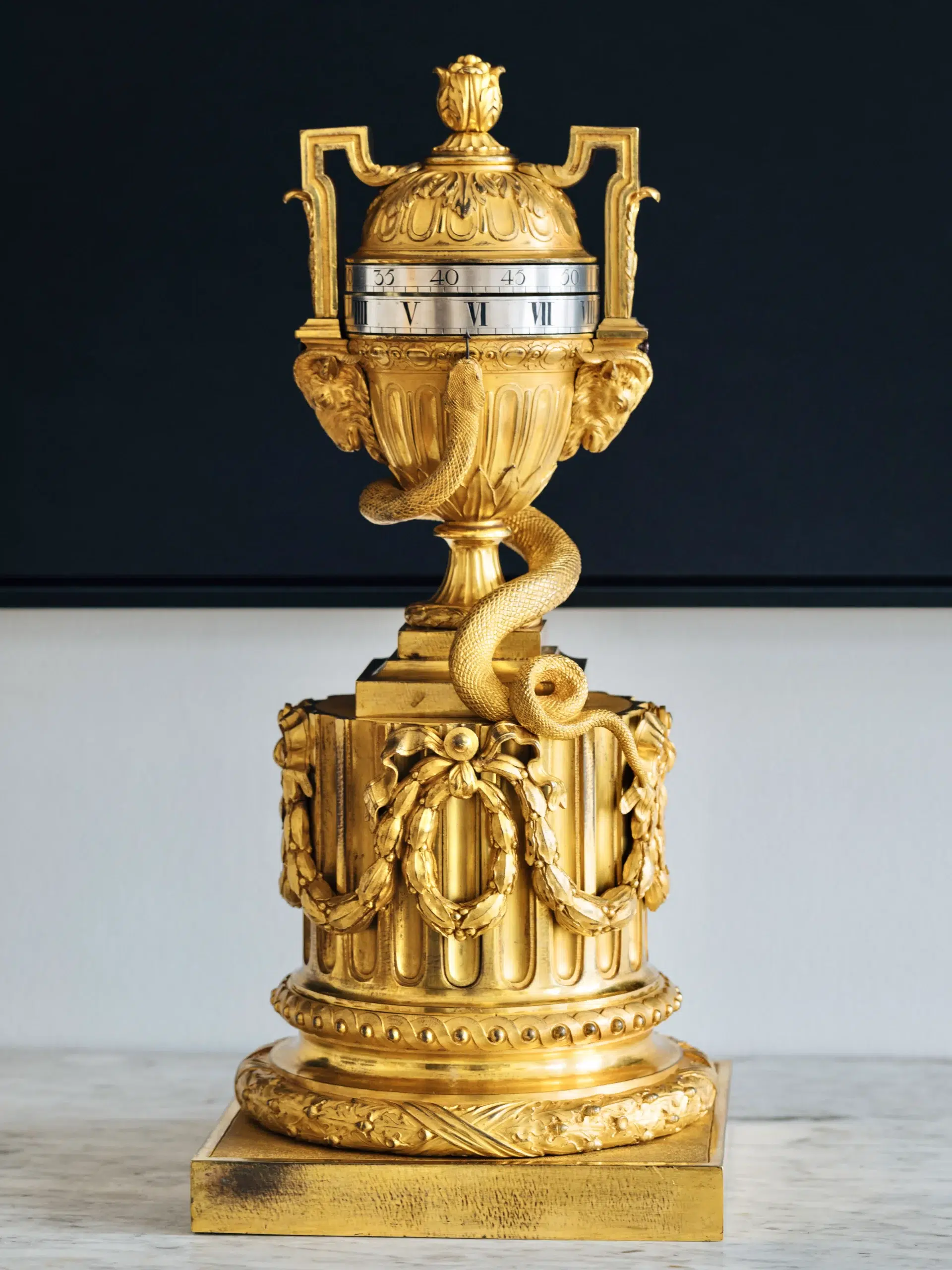France, Louis XVI period, circa 1770 Attributed to Robert Osmond (1711−1789) Mouvement by Verneaux in Paris
Chased and gilt bronze, dials in silver
Close examples:
- Robert Osmond, Drawing of a mantel clock « n° 25 , pièce à colonne quarrée & vazes », Paris, Bibliothèque Doucet (inv. VI E 15 Rés)
- Robert Osmond, Mantel clock, Baden-Baden, musée Zähringer
- Lepaute, Mantel clock, former Demidoff collection, Christie’s Londres, sale of the 18th
- of June 1987, lot 104, private collection
Presumably identical examples from 18th-century collections:
- “A revolving clock, giving the hours & half-hours, movement by M. le Paute, in a worked vase with square handles with ram heads, with snakes entwined around the pedestal, marking the hours, placed on a colored fluted column shaft, with a garlanded bow & laurel torus base, on octagonal plinth: height 19 inches.” (Sale of the M*** collection, by Philippe-François Julliot, Monday November 29, 1784, at Hôtel de Bullion, rue Plâtrière, Paris).
The clock is composed by a fluted column adorned by an oak garland resting, with at the bottom a square base in gilt bronze.
A garland and crowns of laurels tied the ornament of the column. An ovoid vase, with frieze of ovals, acanthus leaves and handles in Greek key are decorated with fine flutes resting on ram’ heads constitutes the upper part of the set. Its lid is decorated with a foliage button.
At half of the height of the vase, this pendulum has a double silver rotating dial, the lower part designating the hours in Roman numerals, the upper part the Arabic numerals indicated by a snake wrapped around the pedestal of the vase.
Keeping the spirit of the return to the Antique which appeared in the mid-18th century, the model of antique vase-shaped clocks was created in Paris in the early years of the second half of the 18th century.
With its particularly elegant turning dial, which broke with the tradition of enameled circular dials, it knew a great success.
The composition of this pendulum can be linked to the work of one of the most important parisian bronzers of the time: Robert Osmond (1711−1789). It drawing is inspired directly by a watercolor which appears in an album of drawings preserved at the National Institute of History of Art in Paris.
Several clocks made in the same spirit are known, including a model signed Lepaute from the Demidoff collections and another signed Osmond belonging to the collections of the museum Zähringer in Baden-Baden.
Robert Osmond (1711−1789)
Born in Normandy at Canisy, near Saint-Lô in 1711, Robert Osmond trained in the workshop of Louis Regnard, foundry master in earth and sand and was received founder-chaser in 1746. Recognized by his peers, he was appointed juror of his corporation in 1756.
In 1753 his nephew Jean-Baptiste Osmond (1742-after 1790) left Normandy to join him. The latter, received master in 1764, worked after that date with his uncle. Their collaboration was so close that it is difficult to distinguish between the contributions of the one and the other. Robert Osmond’s activity took place between the end of the 1740s and the mid-1770s, when in 1781 he was appointed as a former master founder. Jean-Baptiste, who continued to direct the workshop after the departure of his uncle, soon encountered difficulties and went bankrupt in 1784. His uncle Robert died in 1789.
Bronzers and prolific chasers, first illustrated in the rocaille style, in the early 1760s, the Osmond were able to adapt to the new neoclassical style. Even though they have produced all kinds of furnishing bronzes (firedogs, wall-lights and inkstand), they are best known for having left their name on a fairly large number of clocks and cartels whose movements were entrusted to the greatest clockmakers of the time like Jacques Lepaute, Ferdinand Berthoud, Julien Le Roy, Jacques Lepaute, Robert Robin.
His works were particularly prized by great collectors and aristocrats. Thus, the famous financier Beaujon and the Duke of Choiseul-Praslin owned clocks and cartels of his production. Also working for one of the greatest marchand mercier of the 18th century,
Lazare Duvaux, they handed over to Louis XV works for the castle of Saint-Hubert and the Tuileries.
Evocative of the talent of the Osmond, this mantel clock illustrates the inventiveness to early adapt to neoclassicism, using ancient vases, handles in the form of Greek key, truncated columns and laurel garlands while being able to soften them thanks to the presence of a snake rolling delicately around the pedestal. The chasing of this last one testifies more to the excellence of the work of these artists having reached the highest level of mastery of their art.
Bibliography
- Jean-Dominique Augarde, Les ouvriers du temps, Genève, Antiquorum, 1996, p. 109.
- Hans Ottomeyer, Peter Pröschel, Vergoldete Bronzen – Die Bronzearbeiten des Spätbarock und Klassizismus, München 1986, p. 194–195.
- Pierre Verlet, Les bronzes dorés français au xviiie siècle, Paris, Éditions Picard, 1987, p. 131.
Measurements:
- Height: 51 cm – 20 inches
- Width: 23,5 cm – 9 inches
- Depth: 23,5 cm – 9 inches
